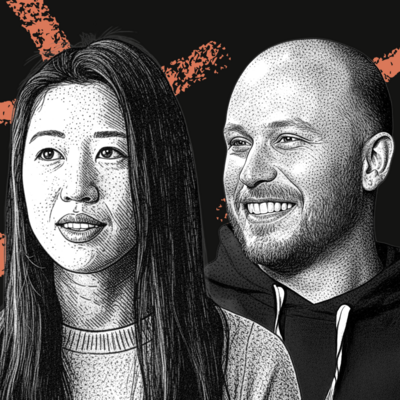
TL;DR: Today we’re releasing a new episode of our podcast How Do You Use ChatGPT? I go in depth with Nicholas Thorne, the founder of AI app Audos and general partner at incubator Prehype. We dive into how Audos enables people to use AI to transform their ideas into businesses. Watch on X or YouTube, or listen on Spotify or Apple Podcasts.
Nicholas Thorne is building Squarespace for the AI age.
It’s called Audos, and it’s an AI chatbot to help any entrepreneur go from idea to pitch deck, working website, custom GPT, and user interviews with real customers. All in just a few minutes, based on the entrepreneur’s responses to a few simple questions.
The best part? Nicholas built, and now operates, Audos using ChatGPT. It’s AI all the way down—and it’s one of the most impressive AI businesses I’ve ever seen.
Nicholas is a general partner at incubator Prehype that launched successful venture-backed startups like Barkbox and Ro Health. It’s also where I started Every, so it was great to come full circle.
Nicholas’s job at Prehype is to launch new companies. He’s taken all his experience of running an incubator and used it to help entrepreneurs start businesses at scale—with AI.
As we talk, Nicholas walks me through the interactions of Audos’s chatbot with a user live on the show. He also tells me that he used ChatGPT to prototype most of Audos’s features—despite being non-technical himself. Nicholas shares exactly how he did this by showing me how he’s using AI to create a new feature for the product.
This episode is a must-watch for anyone who has ever toyed with the idea of starting a business—and wants to do it with AI. Here’s a taste:
- A prototype is worth 1,000 pitch decks. Nicholas believes that founders shouldn’t preemptively evaluate their ideas without gathering feedback from potential customers, a function AI tools can enable. “[A]s much as possible, not a priori making judgments about which of [the founders] ideas were good ones, but instead, just building some early momentum and seeing if anything stuck,” he explains.
- Use AI to stay close to your customers. Once the business is launched, Nicholas advises early-stage founders to remain as connected to their customers as possible. He believes that AI can maintain this connection as the business grows by “interfac[ing] with [customers]” and performing tasks that would otherwise require hiring, thus avoiding “getting sucked back into the organization.”
- AI enables founders to put their ideas into action. As a business scales, Nicholas finds that founders typically become less involved in the execution of their ideas. He asks,“What happens if you can be the first draft maker longer?,” believing that founders can answer this question by using AI tools to “create more first drafts” and increase the “fidelity” of the work product to their vision.
In the next segment of our conversation, Nicholas demos Audos live on the show. He explains that the company’s purpose is to use AI to bridge the idea-to-execution gap for people who think they have the resources, knowledge, and experience to build a business—in other words, to accelerate their process by “put[ting] them in edit mode, not creation mode.”
We dive into how a user of Audos develops his business idea to create an employer match program to help employees save for a new home, instead of a normal retirement account like an IRA or 401K.
- Craft effective chat experiences. Nicholas’s advice for businesses creating chat experiences is to think about the first interaction with the customer because “where you start matters, especially if what you’re trying to steer toward is a fixed outcome” (in Audos’s case, the customer launching a business). Audos’s bot asks the founder to name their ideal customer early on because Audos believes that it’s crucial to “deeply imagine who the person is that they’re going to serve.”
- Understand your customer. Next, the bot asks the user about the needs and wants of their ideal customer. This question is aimed at giving the AI more context about the business idea, and prompting the user to think more deeply about the problem.
- Use AI to refine problem statements. Audos-bot then provides the customer with different “interpretations of the problem,” which Nicholas believes to be important because “if you can be very precise about the problem you’re trying to solve, it just makes coming up with a solution easier.”
- Troubleshoot solutions with AI. After the customer has selected the option that best represents the problem they want to solve, the bot provides “interesting solution alternatives.” Audos uses AI to “pitch a series of potential solutions, which are just across a bunch of different business models and solutions styles,” Nicholas says.
- AI-powered custom presentations. Based on the information gathered, Audos-bot generates a custom presentation in Google Slides, which includes assets like a logo suggestion, pricing options, a map of the user journey, and search volume data for the product. The generation of this presentation is “automatic,” with a set of GPTs working in tandem to create it in “five or six minutes.”
- Incorporate user input. If the user has feedback on this presentation, the bot redirects them to a custom interface where they can edit the “elevator pitch version” that forms the “underpinning of the whole deck,” and “pick new fonts and new colors.” Nicholas adds that the user has the option of “duplicat[ing] that deck” and modifying it according to their preferences.
- Develop tools to gather customer feedback. Once the presentation is finalized, Audos’s bot requests a $30 payment from the user before creating a “set of tools to allow you to start to talk to your customers.” This includes a landing page for the business, a custom GPT to enable the user to “acquire leads,” and assets to help the user run an ad campaign.
- Gather customer insights. After the external-facing resources to gather customer feedback have been prepared, Audos-bot “backs [the user] into the hard work…that [the user] needs to do for [themselves].” The AI designs a set of interview questions based on the “needfinding playbook,” a customer-research method designed by a Stanford design school professor, that the user is required to complete from the perspective of a customer, and share with their friends and acquaintances.
- Synthesize customer feedback with AI. As people respond to the interview, the bot synthesizes the data into a “product roadmap.” “[I]t’ll use these conversations to identify what are the key features of this potential product, and then play them back to you, and organize them in a dashboard,” Nicholas explains.
The degree to which AI is integrated into the functioning of Audos-bot is truly incredible. Even more remarkably, Nicholas tells me that he prototyped most of the product using AI. Here are some insights from this segment of our discussion:
- AI enables more people to build. Nicholas says that ChatGPT helped him build Audos even though he’s a self-proclaimed coding novice. “I just think it's magical that you can say, ‘This is what want to do, can you write me the first version of a script?’ and then you can plug that script in and run it and then just paste the error message, and slowly, but surely if you're patient enough, you can get there,” he remarks.
- Use ChatGPT to build your proof of concept. Even as Audos-bot grows in functional complexity, Nicholas continues to use ChatGPT to blueprint new features. He takes me through a new feature they’re working on, the automation of launching custom GPTs for users, explaining, “I am in the process right now of prototyping that in my prototyping framework, so that I can then hand it to the real engineers…and say, Hey, can you please make this?”
- Establish checks and balances for ChatGPT. Since Nicholas is using ChatGPT to code, an area in which he’s relatively inexperienced, I ask him how he checks if ChatGPT is doing the right thing. “Once you've made the mistake a few times, you can tend to be pretty smart about what the mistake is that you're making and try not to make it again,” he says.
You can check out the episode on X, Spotify, Apple Podcasts, or YouTube. Links and timestamps are below:
- Watch on X
- Watch on YouTube
- Listen on Spotify (make sure to follow to help us rank!)
- Listen on Apple Podcasts
Timestamps:
- Introduction: 00:48
- How AI can make you a more effective founder: 12:10
- Live demo of Audos! 17:01
- Why Nicholas built an AI tool to enable entrepreneurs: 27:11
- How Audos puts you in “edit mode” instead of “create mode”: 28:37
- Tools to gather customer feedback, generated by Audos: 31:29
- How Audos actually works: 36:15
- Nicholas uses ChatGPT to prototype a new feature: 38:47
- How to establish checks and balances while using ChatGPT: 45:54
- AI as a force for pushing entrepreneurship to new heights: 1:00:37
What do you use ChatGPT for? Have you found any interesting or surprising use cases? We want to hear from you—and we might even interview you. Reply here to talk to me!
Miss an episode? Catch up on my recent conversations with investor Jesse Beyroutey, a16z Podcast host Steph Smith, economist Tyler Cowen, writer and entrepreneur David Perell, Notion engineer Linus Lee, and others, and learn how they use ChatGPT.
If you’re enjoying my work, here are a few things I recommend:
- Subscribe to Every
- Follow me on X
- Subscribe to Every’s YouTube channel
- Check out our new course, Maximize Your Mind With ChatGPT
The transcript of this episode is for paying subscribers.
Thanks to Rhea Purohit for editorial support.
Dan Shipper is the cofounder and CEO of Every, where he writes the Chain of Thought column and hosts the podcast How Do You Use ChatGPT? You can follow him on X at @danshipper and on LinkedIn, and Every on X at @every and on LinkedIn.
The Only Subscription
You Need to
Stay at the
Edge of AI
The essential toolkit for those shaping the future
"This might be the best value you
can get from an AI subscription."
- Jay S.
Join 100,000+ leaders, builders, and innovators

Email address
Already have an account? Sign in
What is included in a subscription?
Daily insights from AI pioneers + early access to powerful AI tools






.png)

Comments
Don't have an account? Sign up!